
The Nocturnal Defense of Great Britain in the First World Warby Robert Craig Johnson, ©1998
Please Note : This is a cache of the site http://worldatwar.net/chandelle/v4/v4n1-2/ww1nite.html and is archived here to protect such an excellent and valuable essay. (Ed 11/02)
The Nocturnal Defense of Great Britain in the First World War First steps, 1914-1916 The First World War was not the first conflict in which aerial bombardment of enemy cities played a part. Austrian troops besieging Venice had tried to use free-flying balloons to carry explosive charges and incendiaries across the lagoon to the city. Nor was it the first time that strategic airpower made measurable, material contributions to a war effort. Arguably, the Persian Gulf War or the recent Kosovo War holds this distinction. The First World War did, however, awaken European leaders to the necessity for some sort of defense of population centers that would once have been considered out of range of enemy action. This realization, combined with a serendipitous lack of resources and precedents, produced an air-defense organization that has, in most respects, served as the model for similar organizations since. By 1918, England had invented most of the elements of the modern, integrated air-defense system: interceptors, specialized communications, navigation, blind-landing, and target acquisition equipment, a network of primary and reserve airfields, antiaircraft weapons, an early warning system, and, above all, centralized command and control. By war's end, Britain's defenders could, in principle, assess, track, and plot incoming raids, predict targets, issue warnings, and vector interceptor aircraft against attackers from a central headquarters. Success was, as we shall see, elusive, given the technology available at the time. But the basic approach developed in Britain's between 1914 and 1918 has never been superceded. Pre-war planning and the lack of preparations When war began in 1914, no provision had been made for defending the British Isles from air attacks, despite the existence of strong German naval and military airship fleets and the proven ability of airplanes to fly across the channel with modest loads. Popular sources have at times alleged that this was the result of lack of foresight or imagination on the part of unspecified authorities. But there is little evidence of this. As early as 1909, the Committee of Imperial Defense of the British government took a look at the threat poised by aircraft. This committee proved at once realistic and strikingly forward-thinking. After assessing the potential of the major extant threat, Germany's growing fleet of dirigible airships, the committee concluded that the immediate military potential of aircraft was strictly limited. The inherent difficulty of navigation and control under the weather conditions prevailing over the North Sea and Britain made militarily significant operations unlikely. But the committee nonetheless felt that, in view of the almost universal lack of protection against overhead attack, even modest raids on fortresses, harbors, factories, and encampments might produce significant damage if left unopposed. Unfortunately, the committee concluded that there was no practical way of opposing air raids, given existing technology. Armed airplanes seemed to be the best long-term solution, because they appeared to have more scope for development and better ultimate performance. But, the committee concluded, "until these machines have proved their ability to ascend to great heights,—a point concerning which expert opinion appears divided—this method of employing them must remain in the region of speculation." The Committee of Imperial Defense was hardly the only body to consider the air-defense problem, though it was easily the most sensible. The immediate pre-war years were, if anything, excessively air-minded and prone to exaggerating the military effectiveness of aircraft. For some time, air raids on population centers had been a frequent topic of discussion for popular journalists and forward-thinking military theorists. For the most part, their efforts were too futuristic and too given to exaggeration to affect practical, military policy. Instead, air-mindedness promoted a counterproductive air-raid hysteria that would complicate the defense of Britain in later years. As early as the winter of 1912-13, mysterious, unmarked airships were regularly "seen" gliding through the night skies over every part of Britain. Given the dearth of effective defenses, the speculative nature and modest scope of the threat, and the many more pressing demands facing the British treasury, Britain's failure to make preparations for aerial defense seems entirely justifiable in retrospect. A dedicated, manpower-intensive air-defense organization was simply a luxury that Britain could not afford during the run up to war. In 1914, with the frontline troops in France on the defensive and with enemy submarines threatening to choke off the nation's sources of food and raw materials, with army and navy alike clamoring for ever more cannon, shells, machine guns, and men, no staff officer could possibly justify diverting such desperately needed commodities to combat what was still, at most, a potentially dangerous enemy. As a result, the air defense of Great Britain evolved in haphazard, improvised fashion. Personnel and equipment were drawn from home-based training and naval organizations. Materiel had to be hastily adapted to purposes for which it had never been intended. Equipment had to be tried on actual operations, then abandoned or further developed in almost Darwinian fashion. Early aircraft and aircrews Until late in the war, almost all of the operational flying units were in France. None could be spared for home defense. But a large training organization was based in the home isles. It supplied the bulk of the home-defense aircraft and aircrews for the duration of the war. Night fighting was thus a secondary duty, given the already growing demand for pilots and observers at the front. Combat missions had to be flown by flight instructors who had already had a long, hard day of flying training using aircraft that were always nearly worn-out and often obsolete. But, on the plus side, instructor pilots were among the best qualified and trained of any available to the Royal Flying Corps and Royal Naval Air Service. As the war progressed, many were crack fighter pilots posted home to pass on their skills to the trainees.

Since the latest and best equipment always went to France, the training units were left with worn-out examples or obsolete types, types rejected by front-line units, and equipment developed for quite other purposes than interception, such as seaplanes. In 1914, 1915, and 1916, many were pre-war French designs—under-powered Blériot, REP, and Morane-Saulnier monoplanes, for the most part, supplemented by tired Bristol Scouts and RN seaplanes, such as the Sopwith Schneider and Baby, which were speedy but hampered by their bulky floats. Few of these aircraft had the performance necessary for climbing up to a Zeppelin's cruising altitude, patroling until the raider was spotted, and then overhauling the airship. Zeppelins were not much slower than contemporary aircraft in level flight and enjoyed a much faster climb and higher ceiling.
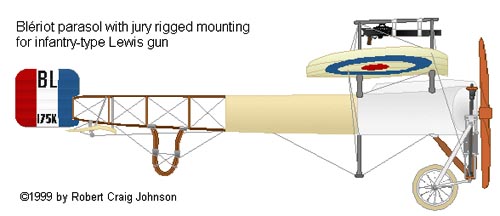
As these miscellaneous aircraft types gradually disappeared from the scene, a reasonably up-to-date but altogether unsuitable design was selected as the standard home-defense fighter: the BE2c. The BE2 was a government product, so it was ordered in enormous numbers. Both airframe and engine were designed and built by the Royal Aircraft Factory at Farnborough in response to a specification for a completely safe military airplane, an airplane that was inherently stable and free of difficult handling characteristics. Unfortunately, the Factory's able designers delivered exactly what the customer ordered. The BE2's was so stable that it could not maneuver against enemy aircraft. The airplane thus proved unsuitable for combat in France. At home, however, dogfighting was not an issue. This, ready availability, and the idea that inherent stability was essential in training and night-flying aircraft led to the decision to standardize on the BE2 for training purposes and, therfore, for home defense. 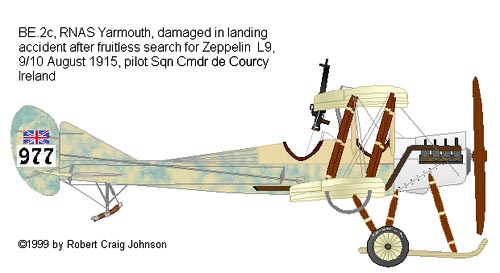
Unfortunately, the type's inherent stability was not as advantageous as had been expected. BE2s crashed more or less as frequently as the less stable types. Yet their performance was generally inferior to that of the old French monoplanes and Bristols. While the RAF 1a engine, an air-cooled V-8 based closely on pre-war Renault practice, was, on paper, the equal of the 80- to 90-hp rotaries that powered the French types, it was, in practice, far less powerful and less reliable. The problem was overheating, particularly during the all-important climb. Pilots could seldom make use of the unit's nominal 90 hp for fear of overheating and engine failure. They had to run the engines on rich mixtures, throttle back, and climb only at the speed and angle best suited for cooling. This, together with the high-drag design of the BE2 airframe, made flight performance mediocre at best. To make the best of it, the aircraft were almost always flown as single seaters, sometimes with the front cockpit permanently faired over. Even so, BE2s could seldom climb anywhere near a Zeppelin's altitude and generally took so much time trying that the raider had usually done its work and departed before the interceptor even saw it.
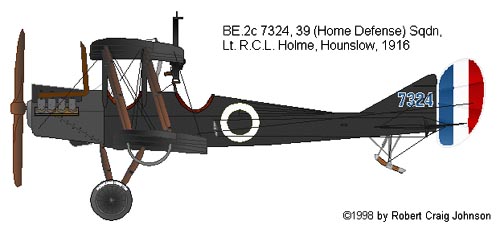
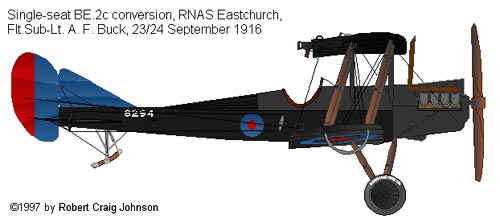
Most aircraft retained the normal finish used by the training squadrons for daylight operations. But, early in the war, special night finish and markings were widely adopted on an informal, ad hoc basis. In photographs, RNAS aircraft appear to carry patchy or mottled camouflage applied over the natural-linen color of the airframe, possibly in blue or green. In August 1916, the commander of 50 Sqdn, Maj. Malcolm Christie, had all of the unit's BE.2s finished in a black dope made from a clear carrier (such as nitrocellulose dope or oil varnish) mixed with lamp black. Other units applied similar dope to the undersurfaces only or used a light overspray to tone down the standard camouflage and markings, an unofficial practice that continued with some units right through the end of the war. To identify the aircraft during daylight training flights, Christie replaced the roundels with simple white circles. Others overpainted the white ring of the standard roundel with red, blue, or the standard PC10 camouflage dope.
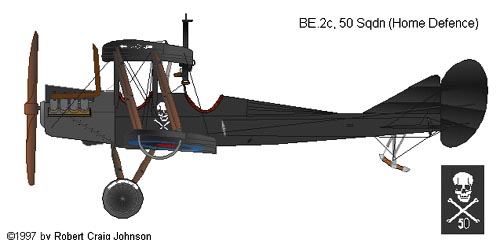
Navigation and blind flying Inadequate flight performance was not the interceptor pilot's main worry, however. Prior to the war, military aviation was primarily thought of in terms of visual reconnaissance, and, since one did not generally reconnoiter when one could not see, few had thought about the difficulties of night flying. Consequently, little provision had been made for blind landing aids or flight instruments. When night operations became necessary, it was too late to do anything quickly. As a result, for the first three yeas of the war, cross-country navigation and landing were so fraught with difficulty that few aviators could manage a nocturnal mission without damaging or demolishing an aircraft. The simplest navigational tasks, such as flying to a town that was under attack or reaching an air field (any air field) at the end of a patrol, became largely a matter of luck. Navigation was a particular problem. In daylight, pilots tried to follow roads, trenchlines, and railways wherever possible. In a pinch they might try to match visible landmarks to their maps or fly a compass bearing until something familiar appeared. While wind drift, unreliable compasses, inaccurate airspeed indicators, and the difficulties of map-reading in a cold, vibrating cockpit made these methods extremely inaccurate, they were generally good enough in daylight and clear weather. The few intrepid pilots who experimented with night flying prewar had found these methods were perfectly acceptable at night, given the brightly lit towns and rail lines of an industrialized nation at peace. Once it got really dark, however, on moonless nights in the wartime black out, these navigational shortcuts failed miserably. Compasses, charts, and flying instruments were, in any case, in short supply, and most were of little practical use when fitted. The harsh vibrational and magnetic conditions common inside early aircraft made compasses, manometers, and similar instruments unreliable. The available maps and charts were intended for ground troops or naval use, and cockpits were almost invariably unlit except for a hand-held flashlight or two. Ground-based navigational aids were nonexistent. Some units attempted to use bonfires and the like to locate targeted towns and landing fields. But such expedients were at least as much help to the enemy. They were thus discouraged by officialdom. The difficulty of locating blacked-out targets was, after all, the most potent defense that Britain had against the airship. Target-location and command and control practices were absent or highly inefficient. Pilots had to take off at the first warning of an incoming raid, because otherwise they stood no chance of climbing to the attackers' altitude. Yet the early reports seldom identified the correct targets. In the absence of any way of communicating with the ground, pilots had to mill about in the dark, chasing shadows, until lack of fuel forced them to risk a landing. Landings were fraught with peril. Landing is always the most dangerous part of a flight, particularly so at night. But in WW1, the dangers were far greater than at any time since. Landing fields were just that—fields, often parcels of waste ground that did not recommend themselves to other agricultural or military uses. They were often sloping, uneven, or rough, frequently boggy, and not always free of dangerous obstructions, like boundary walls, fences, ditches, streams, trees, even livestock. There was no runway per se and no real landing pattern: pilots just gauged the wind and landed willy-nilly, wherever they could. While such air fields were, perhaps, more dangerous than they had to be, the risk was judged acceptable in daylight. At night, when pilots had trouble judging their height above the ground and had little more than a vague notion of being in the vicinity of the field, they were lethal. In 89 RNAS sorties studied, 20 airplanes were wrecked or seriously damaged, three pilots were killed, and eight were injured, two seriously. Such human and material losses were unacceptable, given the number of sorties flown, the results achieved, and the value of aviators who were being risked. By 1915, efforts were underway to solve or at least mitigate the worst of these problems. Due to its considerably greater experience in night and instrument flying, the Navy took the lead. The RNAS Air Department provided pilot-adjustable cockpit lighting for the BE.2 and extended naval-style instruments and daytime training in blind-flying and navigation training to the RFC. Command and control proved a highly intractable problem and was not really solved until radar and the ground-controlled intercept system came into use in the Second World War. Nevertheless, some strides were made. A spotting network was established and connected to coordinating centers by telephone. To give early warning of incoming raids, large sound collectors were tried. In 1915, a 16-ft parabolic sound mirror was carved into a chalk cliff in Kent. It could detect a BE.2 30 to 90 secs before it could be detected by ear and was effective at ranges up to 10.5 miles. A trainable concrete mirror was planned but never installed, because the improved performance was not great enough to justify the effort. Better results were obtained by the simple expedient of feeding observer reports from Flanders to the Home-Defense organization. To communicate the latest target information to patrolling night fighters, an RNAS officer, Lt. Ingram, perfected a code conveyed through white cloth panels: three, 20 x 4-ft (6 x 1.25-m) rectangles and up to three 8 ft-diameter disks. The rectangles were arranged in a "T" on the ground and the circles were placed around it in any of 40 different positions. This system could pass instructions and signal the presence of raiders in 25 pre-defined land and sea locations. At night, it could be seen at 14,000 to 17,000 ft (4310 to 5230 m) under normal weather conditions. Sample Ingram messages are shown below.
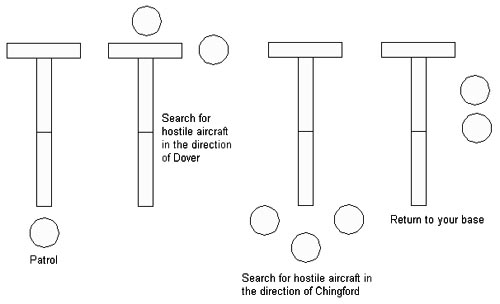
But Capt. F. V. Holt, RFC, introduced the single most widely used landing aid, the Holt flare system. Holt reasoned that most serious landing accidents could be avoided if the pilot could be given a rough idea of his surroundings and even the briefest glimpse of the ground just before touchdown.
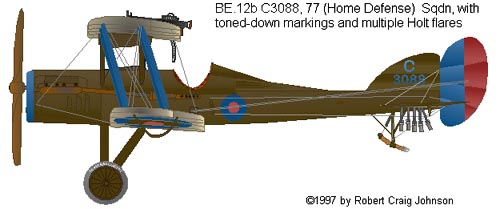
The only problem with Holt flares was glare. The parachute flare proved all but unusable. Magnesium light created harsh and confusing shadows that made an intelligible overview of the ground all but impossible. Worse still, the large, slow-falling flare ruined the pilot's night vision when he needed it most. Most pilots skipped it and used the underwing flares alone. To alleviate the glare of the latter, a metal shield/reflector was at first fitted. But it proved more trouble than it was worth and was soon abandoned. Pilots were instead told to look out from the side opposite a burning flare, but reflections from the airframe often made this tactic less helpful than one might expect. Consequently, crews blacked the rear blades of propellers with lamp-black and black-doped the undersurfaces of the wings (or the whole airframe). Some experimented with alternative locations for the flares and mounted multiple units under the fuselage or tailplane. Despite its limitations, the Holt flare was successful, so much so that it remained in service throughout the world until shortly before WW2. At established airfields, ground crews developed an even simpler aid which is, in principle, still in use today. Cans filled with gas-soaked rags or sand were lined up in a "J" pattern to designate the boundaries of the landing area. When a returning aircraft approached tthe field, the ground crews would ignite the cans to form a flare path. Armament All the aircraft carried woefully inadequate armament in the early years. Their proverbial inflammability not withstanding, Zeppelins were tough targets. The airship's enormous size was protection in its own right. There was so much hydrogen and so little air inside the hull that fires were extremely hard to start (the nitrocellulose dope on the hull fabric was probably a bigger fire hazard than the gas inside). Vital components, such as engines, control cables, and structural members, were duplicated, widely distributed over the hull, and accessible to damage control teams in flight. Gas bags could, of course, be punctured, but it took many, many strikes and considerable time before such large craft noticed any loss of lift. Meanwhile, many well-sited, crew-served machine guns would be firing back at the attacking pilot from a considerably steadier platform than he enjoyed. Machine guns were an obvious antiairship weapon, and a suitable machine gun was, by chance, readily available: the .303-in caliber Lewis, a remarkably light (25-lb/11-kg) infantry weapon fed from a 47- or (later) a 96-round drum magazine. It was reasonably handy, reliable, and easier to load in flight than most of its contemporaries. Unfortunately, while a 50- to 100-round burst of machine-gun fire would cause major structural failure in a contemporary airplane, it had little effect on an airship. Zeppelins were large enough to soak up enormous quantities of the standard .303-in (7.7 mm) ball ammunition without serious damage. With this fact in mind, the Woolwich arsenal developed a theoretically more lethal anti-airship round: the "flaming" bullet. This contained an incendiary compound sufficient to ignite the hydrogen in a Zeppelin. But the amount required was so large large that it would not fit the high-velocity, .303-in service bullet. Instead, the obsolete, .45-in caliber Martini-Henry bullet had to be used. This had been developed for a single shot, lever-actuated, breech-loading rifle that had preceded the .303 Lee-Enfield SMLE as the standard infantry weapon. This used a short-range, low-velocity cartridge designed originally for black powder. The Woolwich flaming bullet was too temperamental for use in machine guns (it was prone to exploding in a hot barrel), even if the only weapon chambered for it, the obsolete, .45-in Navy-pattern Maxim gun, had been light enough for aircraft use. So aircrew were issued with Martini-Henry cavalry carbines. Trying to hit a moving, airborne target at long range with a single-shot carbine while flying an unstable light plane was hardly a promising tactic, even if the Woolwich round had not proved incapable of piercing Zeppelin fabric at combat ranges (British authorities came away convinced that the Zeppelin featured a double hull containing inert engine exhaust as a fire suppressant). Incendiary and explosive bullets were also contrary to the Hague Conventions, which were still being observed in Britain at this time.
Given the limitations of the available small arms, many elements in the army and navy ecommended air-to-air bombing. Suitable weapons were available in the form of the 20-pound (10-kg) Hale HE and 16-lb (8-kg) Woolwich incendiary bombs, supplemented, possibly, by army rifle grenades.
Bombs and darts could be supplemented by the unlikely-sounding and worse-looking Farnborough Fiery Grapnel. This consisted of a pair of four-fluked, anchor-like grappling hooks packed with incendiary composition and fixed to a length of cable. The fighter was supposed to troll with it until the thing snagged on a Zeppelin. Then the grapnel would rip the airship open and set it alight. Bombs, Ranken darts, and the Fiery Grapnel were all top attack weapons, of course. While they were more than destructive enough to bring down a Zeppelin, the airplanes available in 1914 and 1915 had little chance of climbing to above a Zeppelin. Warneford had the good luck to spot LZ37 while en route to a bombing raid on the Zeppelin sheds at Berchem St Agathe. He was already airborne and at a considerable height when he began his famous pursuit. The Zeppelin was still climbing away from its shed over comparatively friendly territory. Had Warneford taken off from an English airfield in reponse to a Zeppelin warning, the results might have been rather less satisfactory. In fact, in every case where a Zeppelin fell victim to bombing, the British pilot enjoyed an atypical height advantage that allowed an attack from above. Since Zeppelins could climb as high as 20,000 ft (6154 m) in a matter of minutes at a time when a good airplane could struggle up to 10,000 to 14,000 ft (300-4000 m) in a couple of hours, such circumstances were seldom to be repeated. When carrying the standard load of two to four 20-lb bombs, a box of Ranken darts, a .303-cal service rifle with rifle grenades, and a Martini-Henry carbine with ammunition or a Lewis gun, plus, perhaps, an observer to help with all the weaponry, a contemporary airplane could have trouble even getting off the ground. In the hopes of alleviating this difficulty, the British investigated a series of weapons that would, it was hoped, carry the bomb's destructive charge up to the airship from below. Rockets, recoiless rifles, and cannon were all tried.
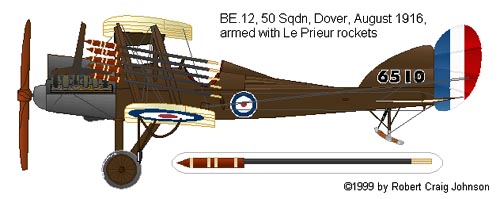
From 1915 to at least 1917, British authorities viewed the French Le Prieur rocket as an ideal anti-airship weapon, despite its many operational deficiencies. The weapon had been used with success against stationary observation balloons on the western front, and contemporary fighters could carry 8 to 10 of them in tubes attached to their interplane struts. The Le Prieur weapons looked exactly like large bottle rockets and worked on the same principle, igniting balloons much as bottle rockets ignite roofs today. The large black-powder charge was extremely effective once it hit a lighter-than-air craft. Unfortunately, in the home-defense role, that never happened. To have any chance of a hit, the pilot had to get unrealistically close to the Zeppelin, and he still had to be above it. With the added weight and drag of the rocket installation, this was even less likely than it had been with bombs. No airship was ever downed by a rocket. Throughout the war years, the Royal Navy experimented extensively with the Davis gun, a recoiless rifle developed by a US Navy commander between 1911 and 1914. The Davis gun worked on the counter-shot principle, in which a mass equal to the shell is ejected to the rear upon firing. In essence, the weapon consisted of a pair of equal-length, light-weight gun tubes mounted breech to breech on a common chamber. For loading, the rear-facing, countershot barrel could be unlocked and pivoted around a rod parallel to the axis of the gun. The round consisted of the high-explosive shell and an equal weight of lead bird shot, with the propellant charge in between. Guns were available for aircraft use in a range of calibers: 2-pounder (~40-mm cal), 6-pounder (~57-mm), 12-pounder (~76-mm), and 50-pounder (~127-mm). The guns had a muzzle-velocity of about 1200 ft/sec (370 m/sec) and an effective range of about 2000 yds (1846 m). The weapons were light, but bulky—10 ft (3.1 m) long. The 2-pounder weighed 70 lbs (32 kg), the 6-pounder 208 lbs, and the 12-pounder 208 lbs, all with mounting.

While all the guns performed impressively and fired extremely destructuve shells, it was quickly found that they could not be readily trained when mounted in ordinary service airplanes, such as the BE.2. The formidable, dual muzzle blasts could severely damage structural members within three ft (1 m) of either muzzle, and the heavy shot charge could destroy any part of the aircraft in its path. This discovery led to a range of designs for bizarre, special-purpose cannon fighters, most of which took their inspiration from warship design practices. The Robey-Peters Davis-Gun Carrier was a three-seat, single-engined biplane with a pair of upper-wing gondolas for the gunners and their Davis guns. The pilot sat well aft, where his view for night takeoffs and landings must have been awful. The 3-bay wings spanned 54.5 ft (16.75 m), and the aircraft was 29.75 ft (9.2 m) long. The gunners sat 12 feet (3.7 m) in the air. The aircraft featured a large, anti-noseover skid and wing-mounted air brakes. Even with a 250-hp Rolls-Royce Eagle engine, the aicraft could barely get off the ground, and it was destroyed in a crash on its first flight. More remarkable still, the Supermarine PB.31E Night Hawk was a twin-engined, 3- to 5-seat, 6-bay, fighter quadruplane equipped with a heated and enclosed cockpit, a bunk for an off-duty crew member, a trainable nose-mounted searchlight, a 5-hp 2-stroke APU, armored fuel and control lines, a 2-pounder Davis gun with 20 shells, and 2 .303-cal Lewis guns. The airplane spanned 60 ft (18.5 m), stood 17.75 ft (5.5 m) high, and was almost 37 ft (11.4 m) long. With two 100-hp Anzani air-cooled radial engines, it was supposed to reach 75 mph and manage patrols of 9 to 18 hours. To give the Davis gun the best possible arcs of fire, it was mounted above the top wing. Unfortunately, the prototype only managed 60 mph at 6500 ft and took an hour to climb to 10,000 ft—both totally inadequate for intercepting airships. Given the Anzani's reputation for unreliability and overheating, it is unlikely that the airplane would have delivered the advertised endurance either. The aircraft was scrapped. (It is however notable that one of the design team was none other than R.J. Mitchell, the designer of the Spitfire.)
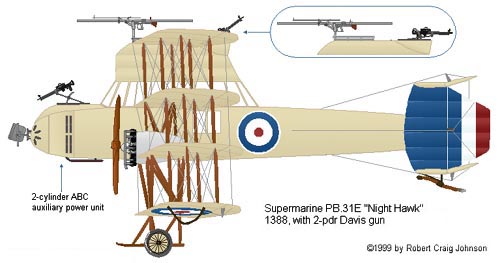
Experiments with the Davis gun soon showed that a devastating shell was not enough to make a weapon effective in air combat. The Davis gun suffered from a low rate of fire, because, for each shot, the gunner had to manually unlock the breech, swing the rear barrel aside, wrestle the oversized cartridge into place, and close the action again, all while trying to keep the gun trained on the target. In action, this made the Davis a one-shot weapon, and, even with the help of a tracer-firing Lewis gun for aiming, single-round hits were all but impossible. In any case, by 1917, when the Robey-Peters and Supermarine gun carriers finally flew, minimally modified, standard, service fighters had proved entirely satisfactory. The Davis gun was relegated to anti-submarine use, mounted on flying boats and RNAS Handley-Page bombers, and soon abandoned altogether. The RFC and RNAS did not give up on the shell-firing aircraft gun, however. An automatic cannon would, it was thought, overcome the principle limitations of the recoiless gun. Fortuitously, two such weapons were available. The more sophisticated design, the 37-mm "C.O.W. gun" from the Coventry Ordnance Works was a pre-war invention, but development was so protracted that it failed to see service use before 1918. It used a long-recoil action, weighed a remarkably light 140 lbs (64 kg), and fired 1.5-lb (0.68-kg) shells from 5-round clips at 60 rpm. Muzzle velocity was 2000 ft/sec (615 m/sec). Unfortunately, recoil was horrific enough that few aircraft could fire it without damage. Many aircraft were designed around the C.O.W. gun in the expectation that its development would proceed smoothly. One of the most extraordinary was the Royal Aircraft Factory FE.6. This combined standard RE.5 wings with a two-seat nacelle and a 120-hp Austro-Daimler engine driving a four-bladed pusher propeller. The tail surfaces were carried on a slender, tubular, metal tail boom that passed through the hollow airscrew shaft. All elevator- and rudder-control cables were routed through the inside of the boomto a point just ahead of the tailplane. A substantial oleo-strut undercarriage was fitted. Needless to say, the structure was dangerously weak and prone to distortion. The aircraft flew for 45 min on its first flight in 1914. But its subsequent history is obscure. By 1915, it had been broken up for RE.5 spares.
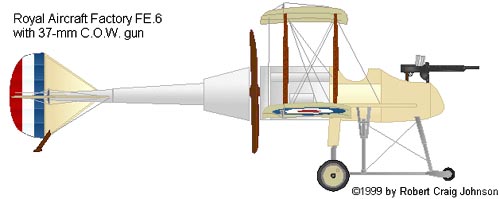
The second weapon was a 19th-century gun created by Hiram Maxim himself, the 1-pounder Maxim QF, better known as the Pom-Pom, for its distinctive sound. Vickers obtained the rights to these weapons pre-war and exported them widely. They were used by the Boers in the Boer War and by both Germany and England as AA guns. The pom-pom was basically a Maxim machine gun chambered for a 37-mm explosive shell, fired from 40-round belts at a muzzle velocity of 1800 ft/sec (554 m/sec) and at 300 rpm. It weighed a hefty 420 lbs (191 kg) and was over 6 ft (1.9 m) long.
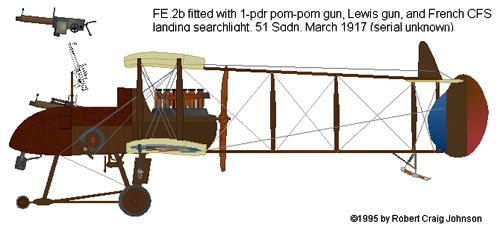
Few aircraft types could carry such a weapon. But, in 1916, experiments at the Admiralty's Orfordness experimental station showed that the Royal aircraft Factory FE.2B pusher biplane could carry the weapon when fitted with the 160-hp Beardmore engine, a license-built version of the Austro-Daimler six-cylinder. Single- and two-seat layouts were tried, but the tempermental belt-feed doubtless required a gunner. For the operational versions, plywood, side-by-side cockpit nacelles were provided for the gun and the two-man crew. The gunner sat to the pilot's right, with the gun directly in front of him on a high-angle mount. A pantographic gunsight sight was provided. No less than five of these aircraft were issued to 51 Home-Defense Sqdn in 1917, but by then it was obvious that the performance of both the gun and the airframe were inadequate for attacking Zeppelins. No interceptions were made. Two similar aircraft went to 100 Sqdn in France and were used for nocturnal train strafing. To be continued ... sadly, this doesn't seem to have happened - a great shame (Ed. 11/2002)
Selected references
Bruce, J.M., The Bristol Fighter Vintage Warbirds 4 (Poole, UK: Arms and Armour Press, 1985) _____, Fighters, vols. 1-3, War Planes of the First World War (Garden City, NY: Doubleday, 1970) _____, Sopwith 1½ Strutter, Windsock Datafile 34 (Berkhamsted, UK: Albatros, 1992) 6, 33, 38 Cole, Christopher and E.F. Cheesman, The Air Defense of Great Britain, 1914-1918 (London: Putnam, 1984) Cooksley, Peter, BE2 in Action, Aircraft Number 123 (Carrollton, TX: Squadron-Signal, 1992) _____, Bristol Fighter in Action, Aircraft Number 137 (Carrollton, TX: Squadron-Signal, 1993) _____, Sopwith fighters in Action, Aircraft Number 110 (Carrollton, TX: Squadron-Signal, 1991) Fredette, Raymond H. Sky on Fire: The First Battle of Britain Smithsonian History o Aviation (Washington, DC: Smithsonian, 1991) Rimell, Raymond L. Air War Over Great Britain, 1914-1918, Vintage Warbirds 7 (Poole, UK: Arms and Armour Press, 1987) Sturtivant, Ray and Gordon Page, The Camel File (Tunbridge Wells, UK: Air Britain, 1993) _____, The S.E.5 File (Tunbridge Wells, UK: Air Britain, 1996) Woodman, Harry, Early Aircraft Armament: The Aeroplane and the gun up to 1918, (Washington, DC: Smithsonian, 1989)
|
© Copyright 1999-2002 CTIE - All Rights Reserved - Caution |
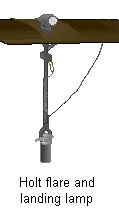 The latter would let the pilot judge his height accurately (inaccurate height assessments were a frequent cause of crashes) while revealing any gross inadequacies in the landing surface. While battery-powered car headlamps and generator-driven searchlights were available, they were never powerful enough to supply useful amounts of light. So, to provide the overview of the landing field, Holt produced a magnesium parachute flare that the pilot could launch from the cockpit. To provide the crucial glimpse of the ground, he developed a smaller flare of his own design mounted on an underwing stanchion. A wind-driven generator and a pair of small, teardrop-shaped landing lights completed the Holt equipment. To land, the pilot would drop the parachute flare (over the side or through a special chute) from about 2000-3000 ft while making a circuit of the field. The flare would burn for two to two-and-a-half minutes—enough time for the pilot to get his bearings and select a touch-down point. At about 300 ft, the pilot would light one of his two underwing flares by pushing an electric button. It would burn for one minute—enough time to check height and surface conditions. If necessary, the second flare could then be lit.
The latter would let the pilot judge his height accurately (inaccurate height assessments were a frequent cause of crashes) while revealing any gross inadequacies in the landing surface. While battery-powered car headlamps and generator-driven searchlights were available, they were never powerful enough to supply useful amounts of light. So, to provide the overview of the landing field, Holt produced a magnesium parachute flare that the pilot could launch from the cockpit. To provide the crucial glimpse of the ground, he developed a smaller flare of his own design mounted on an underwing stanchion. A wind-driven generator and a pair of small, teardrop-shaped landing lights completed the Holt equipment. To land, the pilot would drop the parachute flare (over the side or through a special chute) from about 2000-3000 ft while making a circuit of the field. The flare would burn for two to two-and-a-half minutes—enough time for the pilot to get his bearings and select a touch-down point. At about 300 ft, the pilot would light one of his two underwing flares by pushing an electric button. It would burn for one minute—enough time to check height and surface conditions. If necessary, the second flare could then be lit.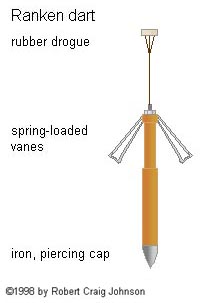 These were certainly destructive enough to destroy something as lightly built as a Zeppelin, and they had been successfuly tested in action. Their advocates could point to RNAS Flt Sub-Lieut R.A.J. Warneford's victory over LZ37 on June 6/7, 1915, using Cooper bombs dropped from Morane-Saulnier Type L Parasol No. 3253, and to the Royal Navy's spectacular successes attacking dirigible hangers in occupied Belgium. But contemporary aircraft could only carry 2-4 at a time. To improve the chances of a hit, the Royal Navy thus developed a specialized anti-airship bomb that could be carried in large numbers, the Ranken dart. The Ranken dart was a slender, drogue-stabilized, 1-lb bomb with a sharp steel nose and four, pivoting vanes at the tail. When the dart hit the airship's skin, the head would punch through while the vanes snagged on the envelope and fired the detonator. The darts were dropped from a 24-round box angled 45º to the rear of the airplane. The pilot approached from 150-700 ft. above the target (300-400 ft. was ideal) and from about 20 degrees off its fore and aft axis. He could drop the darts singly or salvo the load. A 5-lb version was developed later.
These were certainly destructive enough to destroy something as lightly built as a Zeppelin, and they had been successfuly tested in action. Their advocates could point to RNAS Flt Sub-Lieut R.A.J. Warneford's victory over LZ37 on June 6/7, 1915, using Cooper bombs dropped from Morane-Saulnier Type L Parasol No. 3253, and to the Royal Navy's spectacular successes attacking dirigible hangers in occupied Belgium. But contemporary aircraft could only carry 2-4 at a time. To improve the chances of a hit, the Royal Navy thus developed a specialized anti-airship bomb that could be carried in large numbers, the Ranken dart. The Ranken dart was a slender, drogue-stabilized, 1-lb bomb with a sharp steel nose and four, pivoting vanes at the tail. When the dart hit the airship's skin, the head would punch through while the vanes snagged on the envelope and fired the detonator. The darts were dropped from a 24-round box angled 45º to the rear of the airplane. The pilot approached from 150-700 ft. above the target (300-400 ft. was ideal) and from about 20 degrees off its fore and aft axis. He could drop the darts singly or salvo the load. A 5-lb version was developed later.